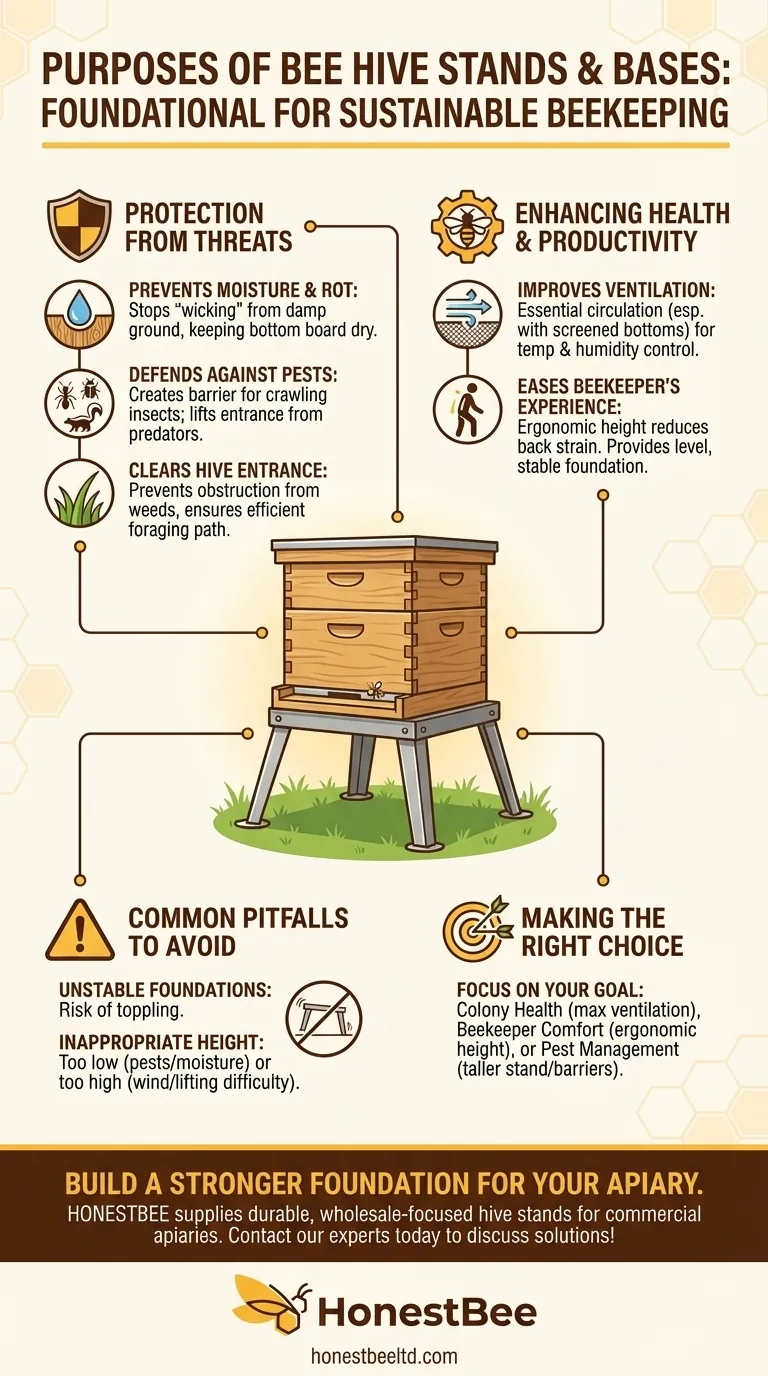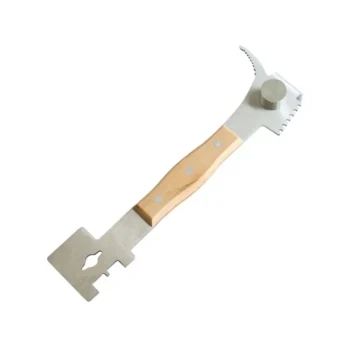At its core, a hive stand is a simple tool used to elevate and secure a beehive. This elevation serves several critical functions, including protecting the hive from ground moisture, defending against pests, improving ventilation, and making hive management easier for the beekeeper. It is a foundational piece of equipment for sustainable beekeeping.
A hive stand is not merely a platform for the hive; it is a strategic investment in the long-term health of the colony and the physical well-being of the beekeeper.

Protecting the Hive from Ground-Level Threats
Placing a hive directly on the ground exposes it to a host of preventable problems. A quality stand provides the first line of defense against these common threats.
Preventing Moisture and Rot
A hive in direct contact with the earth will absorb moisture, especially in damp climates. This leads to the premature rotting of the wooden bottom board, a critical and expensive component.
By lifting the hive, you create an air gap that stops this "wicking" effect. This keeps the wood dry, significantly extending the life of your equipment and helping to regulate the hive's internal humidity.
Defending Against Pests
Elevation creates a significant barrier for crawling pests like ants and beetles. While not a complete solution, it makes the hive a much harder target.
For larger pests, such as skunks or raccoons that prey on bees, a stand lifts the hive entrance out of their easy reach, reducing nighttime disturbances and colony losses.
Clearing the Hive Entrance
A hive on the ground is quickly obstructed by growing grass and weeds. This blocks the bees' flight path and can force guard bees to expend unnecessary energy clearing the entrance.
A stand ensures the entrance remains clear, promoting efficient foraging and better hive ventilation.
Enhancing Colony Health and Productivity
A dry, secure, and well-ventilated hive is a less-stressed hive. The benefits of a stand translate directly into a healthier and more productive honey bee colony.
Improving Air Circulation
Lifting the hive off the ground allows for proper air circulation underneath it. This is especially important for beekeepers using screened bottom boards, as it is essential for ventilation and Varroa mite management.
This improved airflow helps the colony regulate its internal temperature and humidity more effectively, reducing the risk of chalkbrood and other moisture-related ailments.
Easing the Beekeeper's Experience
Beekeeping involves lifting heavy boxes, and constant bending can lead to significant back strain. Elevating the hive to a comfortable working height is one of the most important ergonomic choices a beekeeper can make.
A proper stand also provides a level and stable foundation. This prevents a tall, heavy hive from tipping over in soft ground or high winds, which could be catastrophic for the colony.
Common Pitfalls to Avoid
While using a stand is highly beneficial, a poor choice can create new problems. The goal is to enhance stability and protection, not compromise it.
Unstable Foundations
The single biggest mistake is using an unstable stand. A wobbly or uneven platform is more dangerous than no stand at all, as a toppled hive can kill the colony and create a hazardous situation.
Ensure your stand is on level ground and is sturdy enough to support well over 100-200 pounds (the weight of a productive hive). Cinder blocks are popular for their stability, while dedicated hive stands often have wide, splayed legs.
Inappropriate Height
A stand that is too low may not offer sufficient protection from moisture or pests. Conversely, a stand that is too high can make lifting heavy honey-filled supers difficult and can make the hive more susceptible to wind.
A height of 8 to 18 inches is generally considered the ideal range, balancing protection with accessibility and stability.
Making the Right Choice for Your Goal
The ideal hive stand depends on your specific priorities for your apiary.
- If your primary focus is colony health: Choose a stand that maximizes ventilation and keeps the hive completely clear of ground moisture and encroaching vegetation.
- If your primary focus is beekeeper comfort: Select a stand that raises the hive's bottom box to a comfortable working height, reducing the need to bend or kneel during inspections.
- If your primary focus is pest management: Opt for a taller stand and consider designs with smooth legs or the ability to place the legs in containers of oil to deter crawling insects.
Ultimately, a hive stand is a simple piece of equipment that provides a powerful foundation for a thriving colony.
Summary Table:
| Purpose | Key Benefit |
|---|---|
| Protection from Moisture | Prevents wood rot by keeping the hive dry. |
| Pest Defense | Creates a barrier against ants, beetles, and skunks. |
| Improved Ventilation | Enhances airflow for better temperature and humidity control. |
| Beekeeper Ergonomics | Reduces back strain by raising the hive to a comfortable height. |
| Stability & Safety | Provides a level foundation to prevent tipping. |
Ready to build a stronger foundation for your apiary?
At HONESTBEE, we supply commercial apiaries and beekeeping equipment distributors with durable, wholesale-focused hive stands and bases designed to deliver these critical benefits. Protect your investment, improve colony health, and make hive inspections easier.
Contact our experts today to discuss the right hive stand solutions for your operation!
Visual Guide

Related Products
- Metal Hive Feet Bee Hive Stand for Ant Protection
- Metal Bee Hive Stand Bee Box Stand for Beekeeping
- Plastic Bee Hive Stand for Beekeeping
- Professional Engraved Round Hive Number Tags for Beekeeping
- Multi-Function Hive Tool with Integrated Hammer for Beekeeping
People Also Ask
- What factors should you consider when selecting a hive location? Ensure Your Bees Thrive from Day One
- Why should beekeepers consider using hive stands? Protect Your Hives and Your Back
- What is the best height for a hive stand? Optimize for Pest Control and Beekeeper Ergonomics
- How do bees regulate the temperature of their hive during the summer? Discover Their Natural Cooling System
- What is the role of oxalic acid in plants? A Key to Plant Defense and Internal Regulation



















